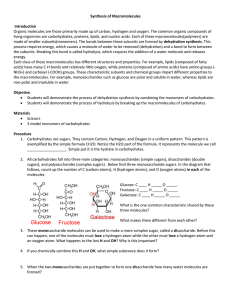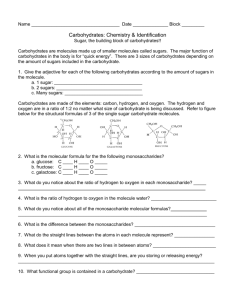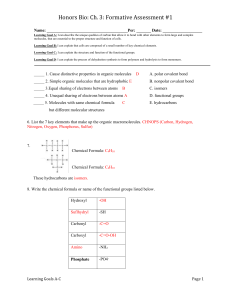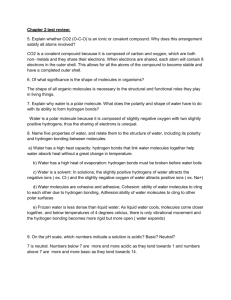MACROMOLECULES: Dehydration Synthesis and Hydrolysis
advertisement
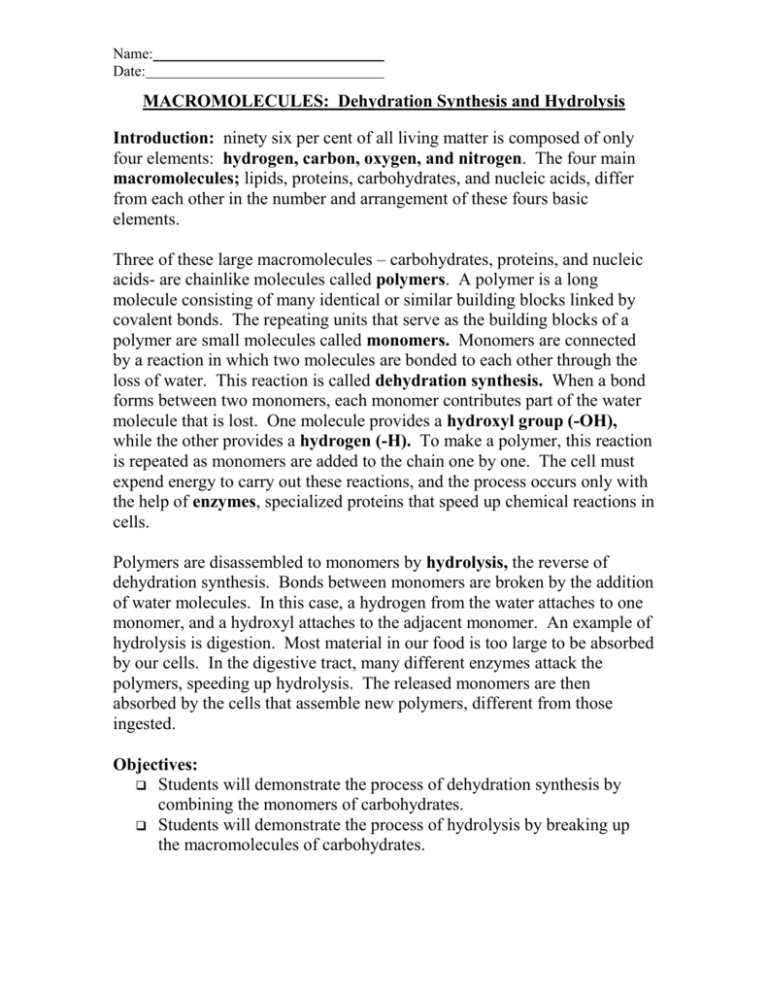
Name: Date: MACROMOLECULES: Dehydration Synthesis and Hydrolysis Introduction: ninety six per cent of all living matter is composed of only four elements: hydrogen, carbon, oxygen, and nitrogen. The four main macromolecules; lipids, proteins, carbohydrates, and nucleic acids, differ from each other in the number and arrangement of these fours basic elements. Three of these large macromolecules – carbohydrates, proteins, and nucleic acids- are chainlike molecules called polymers. A polymer is a long molecule consisting of many identical or similar building blocks linked by covalent bonds. The repeating units that serve as the building blocks of a polymer are small molecules called monomers. Monomers are connected by a reaction in which two molecules are bonded to each other through the loss of water. This reaction is called dehydration synthesis. When a bond forms between two monomers, each monomer contributes part of the water molecule that is lost. One molecule provides a hydroxyl group (-OH), while the other provides a hydrogen (-H). To make a polymer, this reaction is repeated as monomers are added to the chain one by one. The cell must expend energy to carry out these reactions, and the process occurs only with the help of enzymes, specialized proteins that speed up chemical reactions in cells. Polymers are disassembled to monomers by hydrolysis, the reverse of dehydration synthesis. Bonds between monomers are broken by the addition of water molecules. In this case, a hydrogen from the water attaches to one monomer, and a hydroxyl attaches to the adjacent monomer. An example of hydrolysis is digestion. Most material in our food is too large to be absorbed by our cells. In the digestive tract, many different enzymes attack the polymers, speeding up hydrolysis. The released monomers are then absorbed by the cells that assemble new polymers, different from those ingested. Objectives: Students will demonstrate the process of dehydration synthesis by combining the monomers of carbohydrates. Students will demonstrate the process of hydrolysis by breaking up the macromolecules of carbohydrates. Name: Date: Materials: Scissors Glue Monomers of Carbohydrates Procedure: 1. Carbohydrates are sugars. They contain carbon, hydrogen, and oxygen in a uniform pattern. This pattern is exemplified by the simple formula CH2O. Notice the H2O part of the formula. It represents the molecule we call . Simply put, it is the hydrate in carbohydrates. 2. All carbohydrates fall into three main categories: monosaccharides (simple sugars), disaccharides (double sugars), and polysaccharides (complex sugars). Below find three monosaccharide sugars. Count up the number if C (carbons), H (hydrogen’s), and O (oxygen’s) in each of the molecules. Galactose a. Glucose: C b. Fructose: C c. Galactose: C H H O O H O 3. What is the one common thing shared by these three molecules? 4. What makes them different from each other? 5. These monosaccharide molecules can be used to make a more complex sugar, called a disaccharide. Before this can happen, one of Name: Date: the molecules must loose a hydrogen atom while the other must loose a hydrogen atom and an oxygen atom. Why is this important? 6. If we combine this H and OH, what simple substance does it form? 7. When the two monosaccharides are put together to form one disaccharide, how many water molecules are formed? 8. This process is called synthesis because of the loss of water while the reaction is taking place. 9. Examine the three paper molecules. Cut them out along the outer solid lines and then try to put them together as to where they will remain attached if moved. Do they remain attached to each other? Why? . 10. Now cut out an H from one of the paper models and an OH from another one. This leaves a hole on one end of the model and a square sticking out of the end of the other model. Now join the two molecules. What do they form? 11. Join the H and the OH. What does it form? 12. Now add a third monosaccharide to the two you have already formed. What must be done in order for the third sugar to be added? . This molecule containing all three monosaccharides is called a(n) . 13. Glue all of your new molecules onto the typing paper. 14. How many water molecules were lost in making this 3-molecule polysaccharide? Name: Date: 15. Write a simple rule that will tell a person how many water molecules will be lost while putting monosaccharides together to from polysaccharides. 16. The process that destroys molecules into their monomers is called . 17. Explain how this process works on the molecule you just created. .
